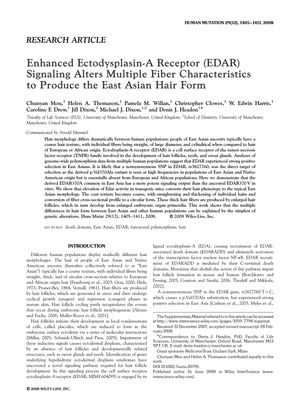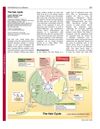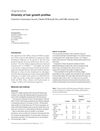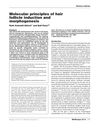Enhanced ectodysplasin-A receptor (EDAR) signaling alters multiple fiber characteristics to produce the East Asian hair form
December 2008
in “Human mutation”

TLDR A genetic change in the EDAR gene causes the unique hair traits found in East Asians.
The study from 2008 investigated the role of the ectodysplasin-A receptor (EDAR) in the development of the characteristic hair form found in East Asian populations. The researchers focused on a single nucleotide polymorphism (SNP), rs3827760, which leads to a variant known as EDAR370A, prevalent in East Asian and Native American populations but almost absent in European and African groups. They found that this variant results in more potent signaling output than the ancestral form of the receptor. In transgenic mice, increased EDAR activity led to hair characteristics similar to those of East Asians, including coarser texture, straightening, thickening of individual hairs, and a circular cross-sectional profile. These changes were due to enlarged hair follicles, which originated from larger embryonic organ primordia. The study concluded that simple genetic alterations in the EDAR gene could explain the distinct hair morphology differences between East Asian populations and others.
View this study on onlinelibrary.wiley.com →
Cited in this study
research The Wnt inhibitor, Dickkopf 4, is induced by canonical Wnt signaling during ectodermal appendage morphogenesis
The study found that the protein Dkk4 helps regulate hair growth by controlling Wnt signaling in mice.
research Involvement of the Edar Signaling in the Control of Hair Follicle Involution (Catagen)
Edar signaling is crucial for controlling hair growth and regression.
research Bone morphogenetic protein signaling regulates the size of hair follicles and modulates the expression of cell cycle-associated genes
BMP signaling controls hair follicle size and cell growth by affecting cell cycle genes.

research The hair cycle
The document concludes that the hair cycle is a complex process involving growth, regression, and rest phases, regulated by various molecular signals.
research Edar Signaling in the Control of Hair Follicle Development
Edar signaling is crucial for proper hair follicle development and function.

research Diversity of hair growth profiles
Different ethnic groups have unique hair growth patterns, with African hair growing slower and less dense, Asian hair growing fast but sparse, and Caucasian hair being densest; men are more likely to experience hair loss than women.

research Molecular principles of hair follicle induction and morphogenesis
Hair follicle development is controlled by interactions between skin tissues and specific molecular signals.

research Induction of the hair growth phase in postnatal mice by localized transient expression of Sonic hedgehog
Activating the Sonic hedgehog gene in mice can start the hair growth phase.